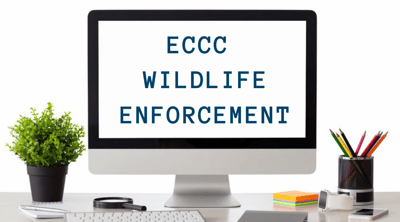Single Window Initiative (SWI): Survival Guide for ECCC Wildlife Enforcement
The new SWI landscape
The Single Window Initiative means several changes for importers:
- how you need to submit documentation is in flux;

- when that documentation is needed has changed; and
- which documentation is required is also shifting.
Our goal is to help you understand what is expected for the new “how, when, and what” of SWI requirements relating to the items you ship. These updates guide importers through specific commodities or categories of commodities, and the Participating Government Agencies (PGAs) that are affected.
How, when, and what
- Single Window Initiative requires all import documentation to be prepared and submitted before the shipment reaches customs.
- SWI is a new way of submitting documentation. All docs will be submitted using the Integrated Import Declaration (IID). Some of the requirements for how you submit are changing. For example: some documents that needed to be faxed now require an uploaded electronic image or just the document number.
- There may be changes to which documents are required under SWI.
- The launch date of SWI is still unknown, but it’s time to get proactive and adjust your workflow to ensure paperwork is ready before you ship.
Why importers need to know
Under the new SWI, it’s important that you understand which Participating Government Agencies (PGAs) are regulating your products. Some products are regulated by multiple PGAs, and the PGAs regulating your products may have changed under SWI. Additionally, each PGA and the CBSA can issue penalties for incorrect and missing documents. Understanding what information and documentation is needed for clearance will make the clearance process into Canada smoother and more efficient.
Environment and Climate Change Canada (ECCC): Wildlife Enforcement
Read more about ECCC's Wildlife Enforcement program here.
Please also refer to these resources:
International trade in protected animals and plants
CITES: Convention on International Trade in Endangered Species of Wild Fauna and Flora
WAPTR: Wild Animal and Plant Trade Regulations
Required data elements for Wildlife Enforcement
The SWI data elements required for release include:
Intended end use
The reason for import must be one of the following:
- Commercial
- Botanical garden
- Scientific
- Personal
- Educational
- Breeding in capacity or artificial propagation
- Zoo
- Circus and travelling exhibition
- Hunting trophy
- Medical (including biomedical research)
- Reintroduction or introduction into the wild
- Law enforcement
Canadian product category
The source of the specimen must be one of the following:
- Specimens taken from the wild
- Ranched specimens
- Appendix I animals bred in captivity for commercial purposes in operations included in CITES Register
- Appendix I plants artificially propagated for commercial purposes, as well as parts and derivatives thereof
- Plants that are artificially propagated, as well as parts and products thereof
- Animals bred in captivity, as well as parts and products thereof
- Animals born in captivity that do not fulfill the CITES definition of “bred in captivity,” as well as parts and products thereof
- Pre-convention specimens
- Confiscated or seized specimens
- Source unknown
Document Type
LPCO (License, Permits, Certificates, Other) documentation is required.
Document Type Description
- CITES Appendix I Canadian CITES import permit issued by Canadian Management
- Authority AND CITES export permit issued by the exporting country OR CITES re-export certificate issued by the exporting country
- CITES Appendix II CITES export permit issued by the exporting country OR CITES re-export certificate issued by the exporting country
- CITES Appendix III CITES export permit issued by the exporting country if the specimen is from a listing nation OR CITES export permit OR a CITES certificate of origin OR a CITES re-export certificate if the specimen is from another nation
- WAPTR Schedule II species Import Permit issued by Canadian Management Authority
Taxonomical Serial Number (TSN) or Aphia ID
Although not required this information may allow a clearer identification of the product.
Commodity identity codes
More than one may apply.
- Tags (CX)
- Tattoos (CY)
- Microchips (CW)
- Wing band (CZ)
- Leg band (CV)
- Other (ML)
Characteristics
- Common name: the common name is a non-scientific name by which the species is described
- Scientific name: provided to facilitate identification of the product and expedite processing
- Age: the age of the animal, plant or any animal or plant part
- Sex: the sex of the animal, plant or any animal or plant part
- Life stage: the life stage of the animal, plant or any animal or plant par.
- Country of source: for goods regulated in Canada under CITES and/or WAPPRIITA, the country in which the goods have been grown or harvested must be provided
Document reference
For every document type provided, the associated reference number for the document must be provided.
Document image
For every document type provided, there must be a digital image of that document provided.
Please note: Original CITES and WAPPRIITA permits must be physically presented to CBSA for validation.
Document issue date
The issue date must be provided in CCYYMMDD format.
Document expiry date
The expiry date must be provided in CCYYMMDD format.
Please note: For every document provided, if different from the importer of record, contact information must be provided (name and address, phone, fax and email).
Importer contact information
Importer name, telephone number or email address is required for release.
Manufacturer contact information
Manufacturer name, telephone number or email address is required for release.
For SWI, being proactive is your best strategy—gather all your information and documentation as far in advance as possible. Importers who know the requirements for the products they’re importing, and understand the new processes under SWI, will have a much smoother import experience.
As you adjust to the new requirements and workflow of the Single Window Initiative, we're here to help. Our customs team is ready to help you understand the SWI and its new requirements for your commodities—contact us today!
SWI. It's what we do.

Latest Articles
- Watch out for these extra charges on your freight bill
- Key differences between duty drawbacks and duty refunds for importers
- Mitigating container shortages and rising shipping prices for ocean imports
- How Canadian importers benefit from end use tariff codes and conditional relief
- The benefits of operating as a Non-Resident Importer in Canada
